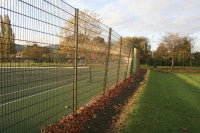Maintenance of synthetic pitches
 Dave Harrison of Campey Turf Care Systems offers a few tips on the ongoing maintenance of synthetic surfaces, suggesting that 'little and often' is the best approach
Dave Harrison of Campey Turf Care Systems offers a few tips on the ongoing maintenance of synthetic surfaces, suggesting that 'little and often' is the best approach
Maintenance of ALL synthetic pitches is best described as "Low Maintenance NOT No Maintenance" and, as with their natural turf counterparts, in general a "little and often" policy is usually best in the long term. Simple and ongoing maintenance carried out from installation onwards will be far more cost effective than waiting until problems occur before trying to rectify them.
Light Brushing
The most important and most frequent maintenance operation will be brushing the surface. However, there may be a requirement for different intensities of brushing at different times, and one brush may not be right for all applications.
 During play, infill material will migrate within the surface level and will tend to migrate away from high intensity play areas like goalmouths and centre circles. If left unchecked, the critical length of exposed pile will be affected in these areas and will be prone to damage. As infill levels are reduced in these areas, performance will also be affected with a significant affect on ball bounce, etc.
During play, infill material will migrate within the surface level and will tend to migrate away from high intensity play areas like goalmouths and centre circles. If left unchecked, the critical length of exposed pile will be affected in these areas and will be prone to damage. As infill levels are reduced in these areas, performance will also be affected with a significant affect on ball bounce, etc.
It is, therefore, essential to brush the surface on a regular basis, to keep the infill mobile and to maintain consistent infill levels throughout the pitch.
Brushing should be light, but aggressive enough to stand up the pile and to move the infill. Rubber crumb in a 3G pitch usually requires a slightly more aggressive brush than a sand infill.
Brushing should ideally take place somewhere between each 10-15 hours of play and, on a pitch that may host sixty hours per week, this will mean around every two days.
Aggressive Brushing
 Both sand and rubber crumb will compact with intensive use, and the ability for water infiltration will be affected. This can be compounded when other organic matter contaminates the infill layers and may result in puddling during heavy rain. With consistent surface water, moss and algae may appear, and the surface will become slippery and dangerous when wet.
Both sand and rubber crumb will compact with intensive use, and the ability for water infiltration will be affected. This can be compounded when other organic matter contaminates the infill layers and may result in puddling during heavy rain. With consistent surface water, moss and algae may appear, and the surface will become slippery and dangerous when wet.
Periodically, it will be necessary to carry out a more aggressive brushing, where the upper infill levels are agitated to decompact them. If regular light brushing has been carried out, aggressive brushing may only be required about every 500 hours (every eight weeks based on approx 60hrs/week use). If frequent light brushing has been neglected, this may be required every 300 hrs (five weeks).
Debris collection
 As mentioned above, it is essential to remove any organic debris before it contaminates the surface, and to remove any litter and potentially harmful debris before play on a daily basis.
As mentioned above, it is essential to remove any organic debris before it contaminates the surface, and to remove any litter and potentially harmful debris before play on a daily basis.
In a secure, controlled area, litter may be minimal but, in urban municipal environments, it is commonplace. Where pitches are close to surrounding trees, falling or windblown leaves may be an issue at certain times of the year, albeit sometimes only in one small part of the pitch.
Collection frequency will obviously be variable, and perhaps seasonal. However, use of a sweeper/collector will show a surprising level of unseen debris is evident in the surface level. Sweeping will also pick up any loose fibres that may be commonplace in the early weeks after installation. Sweeping a football pitch should take less than one hour.
Topdressing
On pitches exposed to high wind, or when snow is removed from the surface, infill can be lost. Over a period of time, infill levels may be reduced to a level where a top-up of sand or rubber crumb is required. This may be across the whole surface or may be in localised areas. In either case, it is most likely that a contractor will be asked to do this job. As frequency cannot be determined, it is difficult to put this into a maintenance schedule.
Other specific maintenance issues
Additional care should also be taken to keep access gates and pathways clean and free from mud and grit. Debris can easily be transported onto the pitch on shoes and the tyres of maintenance equipment.
Keeping surrounds free from weeds is also essential to stop encroachment into the sand infill within the pitch. Spot treatment with a suitable weed-killer may be required periodically.
Hygiene of the pitch is also a critical issue. Players spitting on the surface can lead to problems, especially when cuts or grazes caused by falls and sliding tackles can leave wounds open to infection. Occasional spraying with anti-bacterial agents may also be required from time-to-time.
These are the most common issues relating to ongoing maintenance.
www.campeyturfcare.com
